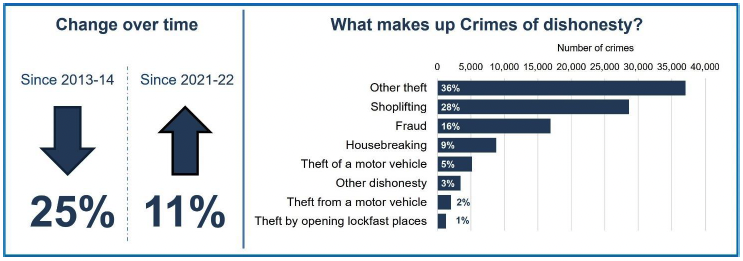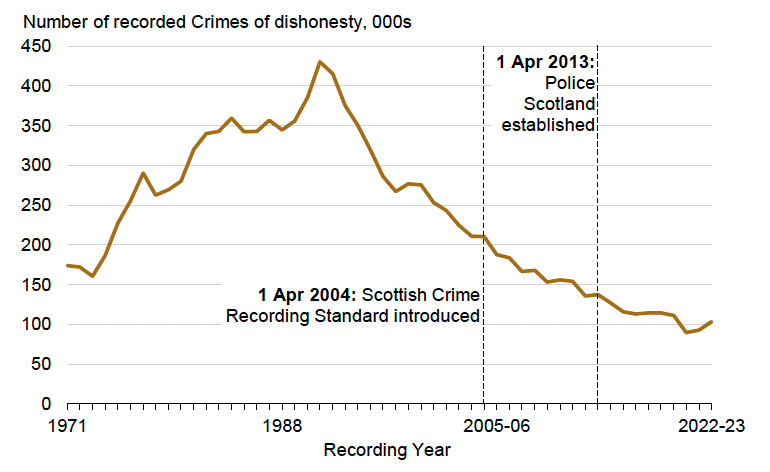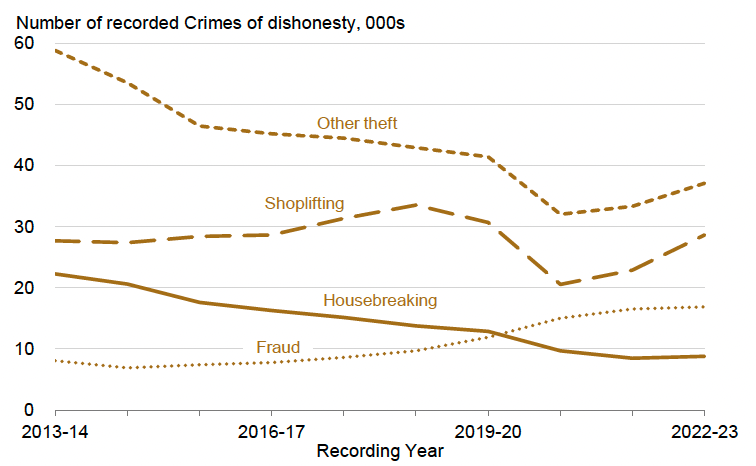Recorded Crime in Scotland, 2022-23
Statistics on crimes and offences recorded and cleared up by the police in Scotland in 2022-23, split by crime or offence group and by local authority.
This document is part of a collection
Crimes of Dishonesty

Crimes of dishonesty is the largest crime group, accounting for over a third (36%) of all crime recorded in Scotland in 2022-23. Between 2021-22 and 2022-23, the number of Crimes of dishonesty recorded by the police in Scotland increased by 11%, from 92,873 to 103,393 and it was the only crime group which increased over this period.
Chart 9 below shows the number of Crimes of dishonesty from 1971 onwards. Crimes of dishonesty increased for a long period since 1971 and peaked in 1991. After then, there has been a long-term decreasing trend, with a decrease of 76% between 1991 and 2022-23. Despite the recent increase, the last three years have had the lowest number of crimes of dishonesty since comparable records began in 1971.

The national rate of recorded Crimes of dishonesty was 189 per 10,000 population in 2022-23, an increase from 169 per 10,000 population in 2021-22.
In 2022-23, of all Crimes of dishonesty:
- Other theft accounted for 36%. This has consistently been the biggest category.
- Shoplifting accounted for 28%
- Fraud accounted for 16%
- Housebreaking accounted for 9%
- Theft of and from a motor vehicle together accounted for 7%
- Other dishonesty accounted for 3%
- Theft by opening lockfast places accounted for 1%
All these categories except Fraud and Shoplifting have seen large decreases in the number of crimes recorded over the past ten years. Shoplifting has seen an increase, up 3% since 2013-14, although it reached a peak in 2018-19. Fraud has seen a large increase, up 109% since 2013-14.
Chart 10 shows the four largest categories within Crimes of dishonesty over the last ten years and gives an indication of the trend and scale of each category.

The following sections discuss in more detail trends for each crime category comprised in the Crimes of dishonesty crime group. These are:
Crimes of dishonesty
- Housebreaking
- Theft by opening lockfast places
- Theft from a Motor Vehicle
- Theft of motor vehicle
- Shoplifting
- Other theft
- Fraud
- Other dishonesty
Housebreaking
Housebreaking accounted for 9% of Crimes of dishonesty. Over the ten year period from 2013-14 to 2022-23 this crime group has decreased by 61%, however there was a 4% increase from 8,489 crimes in 2021-22 to 8,796 in 2022-23.
Theft by opening lockfast places
Theft by opening a lockfast place accounted for 1% of Crimes of dishonesty. Over the ten year period from 2013-14 to 2022-23, this crime has seen a decrease of 60%. The number of crimes recorded in this category has increased by 8% in the most recent year, from 1,203 in 2021-22 to 1,297 in 2022-23.
Theft from a Motor Vehicle
Theft from a motor vehicle accounted for 2% of Crimes of dishonesty. Over the ten year period from 2013-14 to 2022-23 this crime has seen a large decrease of 67%, however there was a 6% increase from 1,936 crimes in 2021-22 to 2,061 in 2022-23.
Theft of motor vehicle
Theft of a motor vehicle accounted for 5% of Crimes of dishonesty. Over the ten year period from 2013-14 to 2022-23 this crime has seen a decrease of 13%. There was a 15% increase in the most recent year, from 4,512 crimes in 2021-22 to 5,182 in 2022-23.
Shoplifting
Shoplifting accounted for over a quarter (28%) of Crimes of dishonesty. There was an increasing trend since 2014-15, which was interrupted by a decrease in 2019-20 and a further larger decrease in 2020-21. This was likely to be due to the Covid-19 pandemic related restrictions. There was a small increase in 2021-22 then a further increase of 25%, from 22,913 crimes in 2021-22 to 28,619 in 2022-23. This is only 15% lower than the high in 2018-19. Over the ten-year period from 2013-14 to 2022-23, this crime has seen an increase of 3%.
Other theft
Other theft consists of Theft of pedal cycles, Theft from a motor vehicle not elsewhere classified and Theft not elsewhere classified (excl. motor vehicles).
This category is the largest in Crimes of dishonesty, accounting for 36% of these crimes. Over the ten year period from 2013-14 to 2022-23, Other theft has seen a decrease of 37%, however there was an 11% increase in the most recent year, from 33,305 crimes in 2021-22 to 37,084 in 2022-23.
Fraud
Crimes of Fraud accounted for 16% of Crimes of dishonesty. Fraud has increased year-on-year since 2014-15, increasing by 109% since 2013-14. There was a 2% increase in the most recent year, from 16,536 crimes in 2021-22 to 16,879 in 2022-23.
Much of the recent increase in Fraud has related to cyber-crimes which are estimated to account for half of all Frauds (51%) in 2022-23 and saw a significant rise during 2020-21. Further information on this change is available in the Cyber-crime chapter.
Other dishonesty
Other dishonesty includes crimes of Reset, Corruption, Embezzlement, and other crimes of forgery which are not classified elsewhere.
Other dishonesty accounted for 3% of Crimes of dishonesty. Over the ten year period from 2013-14 to 2022-23 this crime has seen a decrease of 32%, including a 13% decrease in the most recent year, from 3,979 crimes in 2021-22 to 3,475 in 2022-23.
Contact
Email: JusticeAnalysts@gov.scot
There is a problem
Thanks for your feedback